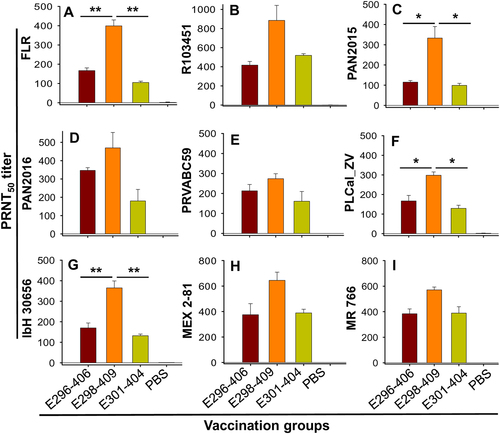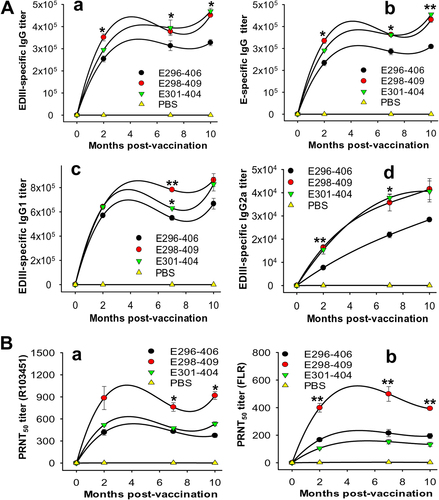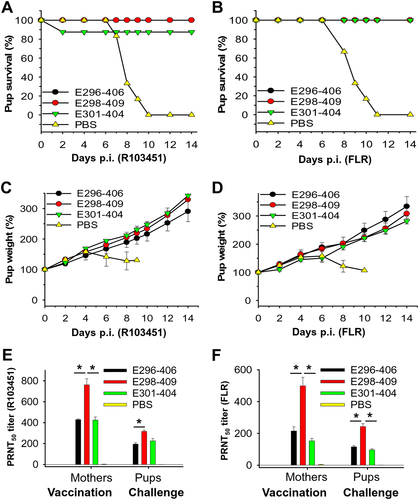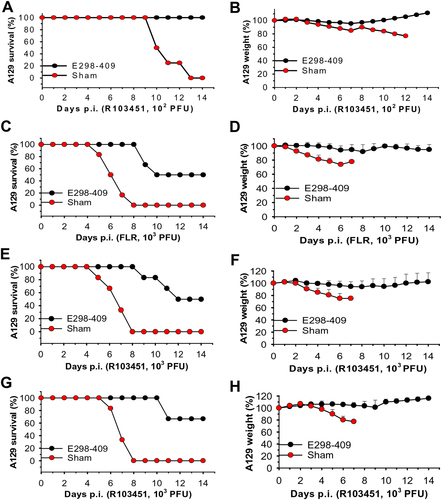Figures & data
Mouse sera from 2 months post immunization with ZIKV EDIII fragments or PBS control were tested by PRNT assay against infection with ZIKV strains isolated from human, including FLR (a), R103451 (b), PAN2015 (c), PAN2016 (d), PRVABC59 (e), PLCal_ZV (f), and IbH 30656 (g), as well as from mosquito, MEX 2-81 (h), and rhesus, MR 766 (i). Neutralizing activity is expressed as 50% neutralizing antibody titer (PRNT50), and the data are presented as the means ± SE of the mice in each group (n = 5). Significant differences were noted between E208-409 and the other two EDIII fragments against FLR (**P < 0.01), R103451 (*P < 0.05), PLCal_ZV (*P < 0.05), and IbH 30656 (**P < 0.01), respectively. The experiments were repeated twice, and similar results were obtained

(A) Mouse sera collected before immunization and 2, 7, and 10 months post immunization with ZIKV EDIII fragments or PBS control were tested by ELISA for ZIKV EDIII (a) and/or E (b)-specific IgG, IgG1 (c), and IgG2a (d) antibodies. The antibody titers were expressed as the endpoint dilutions that remained positively detectable and are presented as the means ± SE of the mice in each group (n = 5). For EDIII-specific IgG (a), significant differences were observed between E298-409 and E296-406 at 2, 7, and 10 months (*P < 0.05), and between E296-406 and E301-404 at 10 months (*P < 0.05) post immunization. For E-specific IgG (b), significant differences were found between E298-409 and E296-406 at 2, 7 (*P < 0.05), and 10 months (**P < 0.01), and between E296-406 and E301-404 at 7 (*P < 0.05) and 10 months (**P < 0.01) post immunization. For IgG1, significant differences were noted between E298-409 and E296-406 (**P < 0.01), and between E298-409 and E301-404 (*P < 0.05) at 7 months post immunization. For IgG2a, significant differences occurred between E298-408 and E296-406 at 2 months (**P < 0.01), and between E298-409 or E301-404 and E296-406 (*P < 0.05) at 7 months post immunization. (B) The aforementioned sera were tested by PRNT assay against infection with ZIKV R103451 (a) or FLR (b) strain. The neutralizing antibody titers were expressed as PRNT50 and are presented as the means ± SE of the mice in each group (n = 5). Significant differences occurred between E298-409 and the other two EDIII fragments against R103451 (*P < 0.05) and FLR (**P < 0.01), respectively, at the indicated months post immunization. The experiments were repeated twice, and similar results were obtained

Groups of 7-day-old pups (n = 6) born to female BALB/c mice immunized with ZIKV EDIII fragments or PBS control were challenged with ZIKV (5 × 104 PFU), and percentages of survival in the ZIKV R103451 (a) or FLR (b) strain treatments, as well as percentages of weight in the ZIKV R103451 (c) or FLR (d) treatments, were recorded for 14 days p.i. The data in c and d are presented as the means ± SE of surviving pups in each group. Neutralizing antibody titers of sera of mothers at the time of pregnancy and surviving pups at 14 days p.i. in the ZIKV R103451 (e) or FLR (f) strain treatments are expressed as PRNT50. The data are presented as the means ± SE of sera of pregnant mothers (n = 5) or surviving pups in each group, and the experiments were repeated twice with similar results. Significant differences (*P < 0.05) between E298-409 and E296-406 or E301-404 are shown

Groups of 7-day-old pups (n = 6) born to naive BALB/c mice were adoptively transferred with sera of mice immunized with EDIII fragments and challenged with ZIKV (5 × 104 PFU) 6 h later. The neutralizing antibody titers (PRNT50) from adoptively transferred sera in the ZIKV R103451 (a) or FLR (b) strain treatments are shown. All sera were adjusted to an equal titer (104) of IgG antibody specific to ZIKV EDIII. Percentages of survival of pups challenged with ZIKV R103451 (c) or FLR (d), as well as percentages of weight of pups challenged with ZIKV R103451 (e) or FLR (f), were recorded for 14 days p.i. The data in e and f are presented as the means ± SE of surviving pups in each group. Pups infected with ZIKV only were included as sham controls. “Two doses” (in c–f) indicates that pups were adoptively transferred with two doses of the above sera 6 h before and 12 h after ZIKV infection

The following three experiments were carried out in 5-week-old A129 mice (n = 6). Mice infected with ZIKV only were included as sham controls. (1) Mice were passively transferred with anti-E298-409 sera (e.g., 105 ZIKV EDIII-specific IgG antibody titer), then challenged with ZIKV R103451 (102 PFU) 6 h later, and percentages of survival (a) and weight (b) were calculated for 14 days p.i. (2) Mice were passively transferred with the above sera 6 h before and 12 h after infection with the ZIKV FLR (c, d) or R103451 (e, f) (103 PFU) strains, and percentages of survival were recorded for FLR (c) and R103451 (e), as well as weights from FLR (d) and R103451 (f), for 14 days p.i. (3) Mice were passively transferred with the above sera 6 h before and 12, 24, and 48 h post-challenge with ZIKV R103451 (103 PFU), and percentages of survival (g) and weight (h) were recorded for 14 days p.i. The data in b, d, f, and g are presented as the means + SE of surviving mice in each group

(A) Five-week-old A129 mice (n = 6) were passively transferred with anti-E298-409 sera (e.g., 105 ZIKV EDIII-specific IgG antibody titer), challenged with ZIKV R103451 or FLR (103 PFU) strains 6 h before and 12 h after infection, and detected for ZIKV RNA by qRT-PCR in tissues (brain, lung, kidney, liver, and spleen) and sera at 3 days p.i. The data are presented as the means ± SE of six mice in each group. The experiments were repeated twice and similar results were obtained. Significant differences (*P < 0.05; **P < 0.01; ***P < 0.001) were seen between E298-409 and sham control groups in the test tissues and sera. (B) Five-week-old A129 mice were passively transferred with anti-E298-409 sera (a, c), infected with ZIKV R103451 as above, and detected for pathological changes at 5 days p.i. Representative images from mouse brain (a, b) and lung (c, d) tissues are shown. The H&E-stained tissue sections were observed under light microscopy (×10 magnification). Sham control, A129 mice infected with ZIKV R103451

